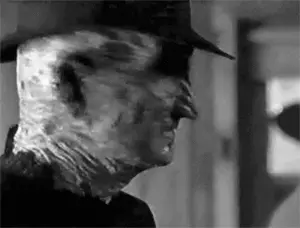health
news
The Greatest Medical Mysteries in History
Dying in a Nightmare: Freddie Kruger Syndrome
Did you think that "A Nightmare on Elm Street" is a fictional story?
In your dreams.
The director drew the idea for the film from a series of frightening and mysterious deaths that occurred in the United States in the early eighties.
Tags
medical history
Sleep
Freddy Krueger
Nightmare on Elm street
Dreams
cradle death
Strider Schleider Putschnik
Friday, 06 August 2021, 07:26 Updated: 07:36
Share on Facebook
Share on WhatsApp
Share on general
Share on general
Share on Twitter
Share on Email
0 comments
"Nightmare on Elm Street" The horror film that scared us all to death in the 1980s (a time when parental control over content their children watched was, how to say - a little looser than it is today), is based on the story of a monstrous creature, with blades instead of hands and Children and teenagers and teens and tears them to pieces out of sleep, causing their deaths in reality as well.
At the time, Freddie Kruger's story was not presented as a film based on a true story, but it turns out to have a realistic foundation.
Screenwriter and director Wes Craven said the idea for the horrific plot came to his mind after reading a series of articles in the LA Times that dealt with the story of several young men who came to the U.S. as refugees from Southeast Asia, and with no apparent contact or relevant health background, all died under mysterious circumstances. - They reportedly "cried out of sleep and then just died".
More on Walla!
Who puts cyanide in paracetamol?
A 40-year-old murder mystery
To the full article
In the 1980s quite a few refugees from Asia, most of them Hmong (an ethnic group of Laos and Thais many of whom collaborated with the US during the Vietnam War) died in these frightening circumstances - US authorities began to monitor this affair in an orderly manner only In 1981 and since then at least 117 such deaths have accumulated over 10 years.
Health authorities began calling the phenomenon "Asian Death Syndrome," and later renamed it Sudden Unexpected Nocturnal Death Syndrome, or SUNDS for short.
Hello hello and come to me in a dream.
Freddie Kruger (Photo: ShutterStock)
In Asia, too, the frightening phenomenon was not missed, and the syndrome was also given different names in the local languages of Japan (Pokuri), the Philippines (Bangongot) and Thailand.
But in all of them the meaning was almost the same: 'horror death,' "Dr. Robert Kirchner told the LA Times sometime in 1987. This journalistic story fascinated the American public, and U.S. authorities were quite bewildered.
"We only found one big thing"
"I know what they did not die from: they did not die from a bullet to the head, or from a stab wound to the chest. They did not fall from the roof and they did not die from poisoning. This was stated by Dr. Michael McGee, assistant district pathologist in Ramsey County, Minnesota, in an interview with the New York Times, after another accumulation of 4 deaths from the mysterious syndrome. That we discovered a third and fourth case.
But then we started to wonder. "
Autopsies performed on 18 other victims of the syndrome revealed two findings: an enlarged heart and disruptions in the conduction system - which is responsible for activating and timing the contractions of the heart muscle. Dr. Friedrich Ackner of the University of Illinois School of Medicine These said in a dramatic statement that it seemed like "their hearts just made short."
More on Walla!
The strangest medical mysteries of all time
The perfectly plausible scenario that caused a man's penis to get stuck in a bottle
"That's how we quit smoking and got out of a risk group"
Almost all of the victims were refugees who had just arrived in the United States from Southeast Asia. An Asian man is sitting in bed (Photo: ShutterStock)
To die at the time of death
In 1987, a more systematic and thorough examination of the cases accumulated up to that point in time was conducted, and its findings were published in the American Journal of Public Health.
The study was based on deaths found in both the U.S. and refugee camps in Thailand - where the prevalence of deaths due to the syndrome was even more common. With them in the refugee camps in Thailand.
In quite a few cases, the researchers found that the victims had suffered from sleep disorders in the past. In the case of one of the victims, in this case a young woman, her parents told of an incident in which they found her breathing unusually out of sleep. Because they had already heard about the deaths in her sleep, they desperately tried to wake her up, and after a few minutes she regained consciousness. However, a little less than three years after that stressful incident it happened again, and this time it ended differently. The young woman died in her sleep from difficulty breathing in front of the eyes of her shocked parents. In another case, a 25-year-old man awoke from his sleep with difficulty breathing. He said he lost sensation in his legs and suffered from weakness. A medical examination performed on him did not reveal anything unusual. He died in his sleep during a nap that very day.
One of the researchers' findings was that there was a higher probability of death from the syndrome among families in which one such case had already occurred. Another finding spoke of a relatively high incidence of epilepsy among the victims. Both point to a genetic factor that is most likely involved in the syndrome.
"It's like their heart made short."
Heartbeat beating (Photo: Giphy)
“Victims who died from the sudden syndrome in the U.S. tended to be relatively new immigrants, compared to the control group.
"Indicators that immigrants who recently arrived in the United States are at higher risk for this type of mortality compared to immigrants from the same ethnic group who have been in the country for a longer time," the researchers wrote in their summaries, noting that stress .
There was even one lecturer at the University of California who argued that the fact that the Hmong believe in the mythology of ghosts haunting people in their nightmares is a contributing factor to these deaths.
She explained that although death was probably the result of some heart defect, the additional stress the victims experienced due to their beliefs served as a trigger.
Epilogue: Solving the mystery
This medical mystery was eventually resolved, although it came many years after the panic that spread in the United States and also after Freddie Kruger's fame passed: Brugada syndrome. It is a genetic syndrome caused by mutations in the SCN5A gene that cause heart rhythm disorders The mutations are inherited, and are probably also associated with an increased tendency to die in the crib (typical of infants).
Share on Facebook
Share on WhatsApp
Share on general
Share on general
Share on Twitter
Share on Email
0 comments













